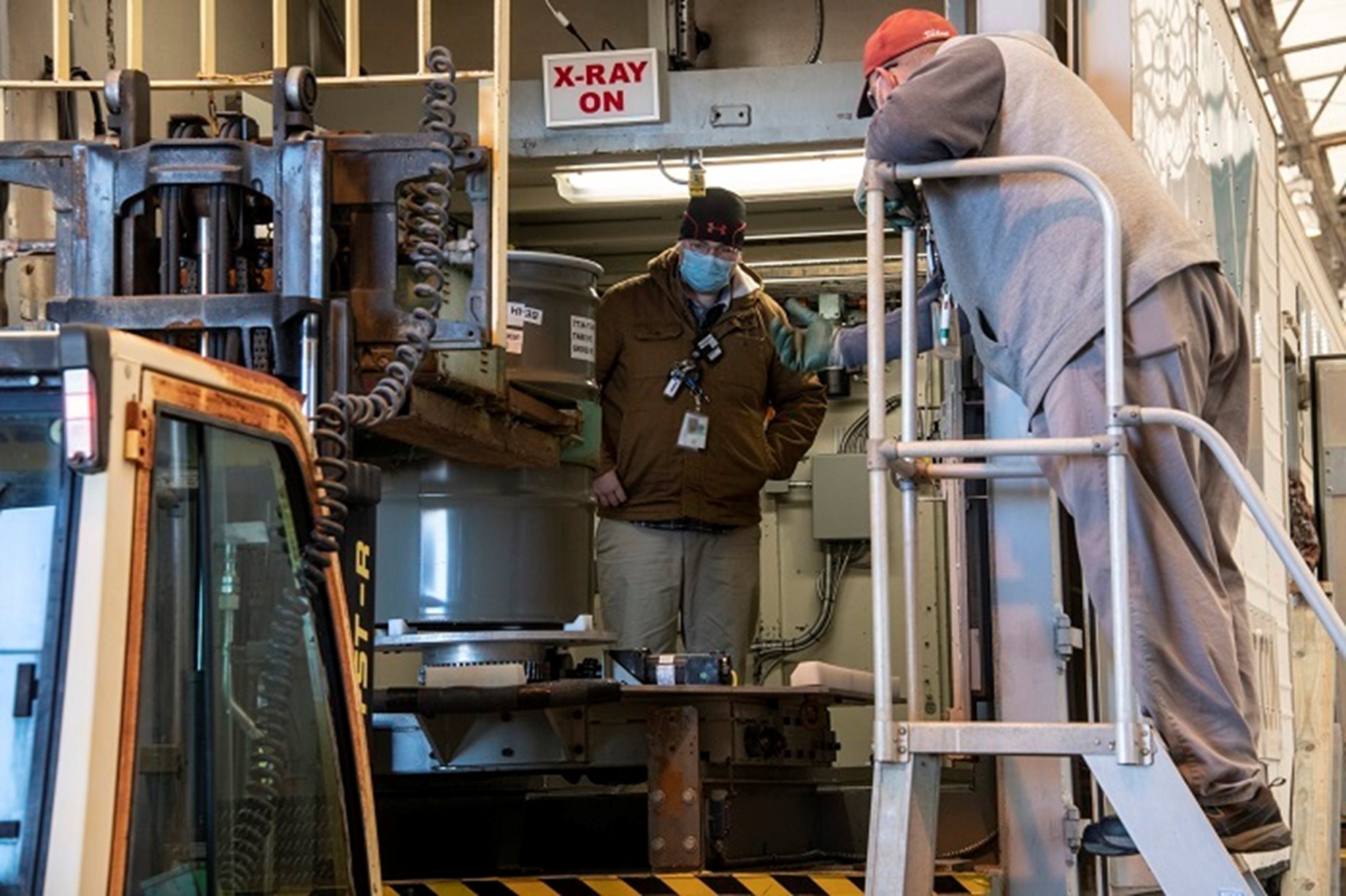Holtec’s HI-STAR 190 spent nuclear fuel transport cask. India’s NPCIL ordered the company’s smaller HI-STAR 149 cask for use at its Kudankulam plant. (Photo: Holtec)
Holtec International announced yesterday that its India-based subsidiary, Holtec Asia, has received an order from Mumbai-based Nuclear Power Corporation of India Limited (NPCIL) for two HI-STAR 149 transport casks to serve the away-from-reactor storage facility for the Kudankulam nuclear power plant.
Operators load a TRU waste drum into a real-time radiography unit for characterization at the Solid Waste Management Facility at the Savannah River Site. (Photos: DOE)
Operators at the Savannah River Site’s Solid Waste Management Facility can now characterize and certify newly generated TRU waste through the use of a real-time radiography unit that uses an X-ray system to examine the contents of waste containers. The equipment was recently installed to meet updated requirements set by the Department of Energy’s National TRU Program that involve evaluating the containers for chemical compatibility and oxidizing chemicals.
The shipments of TRU waste from SRS, in South Carolina, are sent to the Waste Isolation Pilot Plant (WIPP), in New Mexico, for disposal.
John Hopkins (left), NuScale Power’s president and CEO, and Marcin Chludziński, president of KGHM’s management board, sign the agreement on February 14. (Photo: Business Wire)
At an event held on February 14 at the Chamber of Commerce in Washington, D.C., small modular reactor developer NuScale Power inked an agreement with KGHM Polska Miedz S.A., to initiate deployment of NuScale’s SMR technology in Poland.
The Relativistic Heavy Ion Collider at Brookhaven National Laboratory. (Photo: DOE)
The Department of Energy has announced an $18 million funding opportunity for research and development in particle accelerator science and technology for nuclear physics research. Provided through the DOE’s Office of Science, the funding is intended to support “efforts essential to developing world-leading core competencies and transformative technologies that significantly advance the state-of-the-art accelerator capabilities.”
The interior of the Submarine 1st Generation Westinghouse prototype, located at the Naval Reactors Facility on the INL site, circa mid-1950s. (Photo: DOE)
The Department of Energy’s Office of Environmental Management (EM) announced on February 10 that it is set to deactivate and demolish the prototype for the reactor used for the USS Nautilus, the world’s first operational nuclear-powered submarine and the first submarine to complete a submerged transit of the North Pole.
[Click to view full image] Cutaway of the HPR1000 design. (Image: CGN)
The Office for Nuclear Regulation (ONR) and the Environment Agency (EA) have found the UK HPR1000 reactor suitable for construction in the United Kingdom, the regulators jointly announced last week.
Mining at McArthur River takes place between 530 and 640 meters belowground. (Photo: Cameco)
Citing “improving market sentiment,” Tim Gitzel, president and chief executive officer of the Canadian uranium mining company Cameco, announced on February 9 the planned restart of operations at the McArthur River mine in Saskatchewan.
Beaver Valley in Pennsylvania is one of the U.S. nuclear power plants identified by the Nuclear Decommissioning Collaborative as being at risk of closure. (Photo: NRC)
The Department of Energy’s Office Nuclear Energy has launched a $6 billion program aimed at preserving the existing U.S. fleet of nuclear power reactors. Established under the Bipartisan Infrastructure Law, the Civil Nuclear Credit Program will allow owners and operators of commercial nuclear power reactors at economic risk of shutting down to apply for credits via a sealed bid process.
An advanced nuclear reactor technology park is hoped for the 935-acre Clinch River site. Image: TVA
The Tennessee Valley Authority’s board of directors has given the go-ahead for a program that will explore the development and potential deployment of small modular reactors as part of the utility’s decarbonization strategy.
The interior of JET with a superimposed plasma. (Image: EUROfusion)
A new record has been set by the world’s largest operating tokamak, the Joint European Torus (JET). According to the EUROfusion scientists and engineers who work on JET at the U.K. Atomic Energy Authority’s Culham Centre for Fusion Energy, the landmark experiment, announced on February 9, which produced 59 megajoules of fusion energy over five seconds, is powerful proof of fusion’s potential as a clean energy source.



















.jpg)

 Today’s #ThrowbackThursday post looks at the initial debate surrounding the conversion of research reactor fuel from high-enriched uranium to low-enriched uranium. An article published in the
Today’s #ThrowbackThursday post looks at the initial debate surrounding the conversion of research reactor fuel from high-enriched uranium to low-enriched uranium. An article published in the